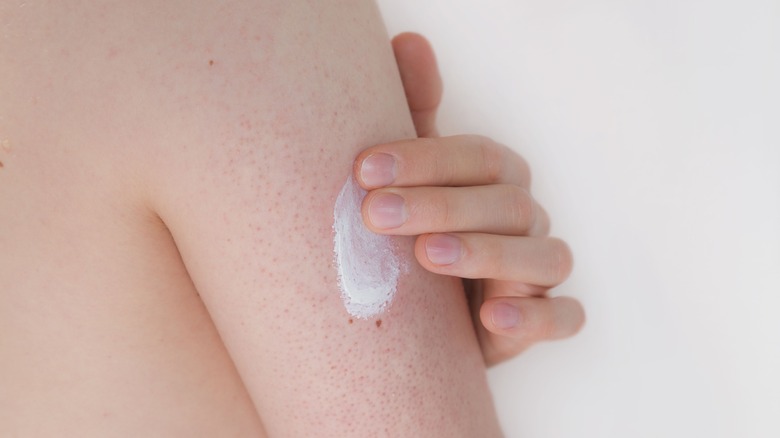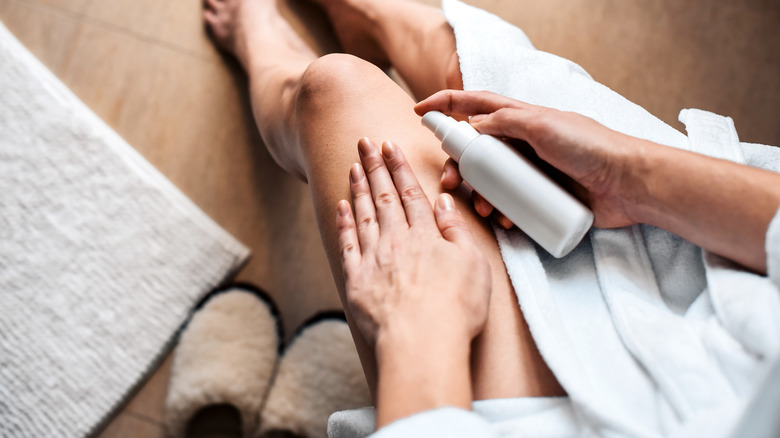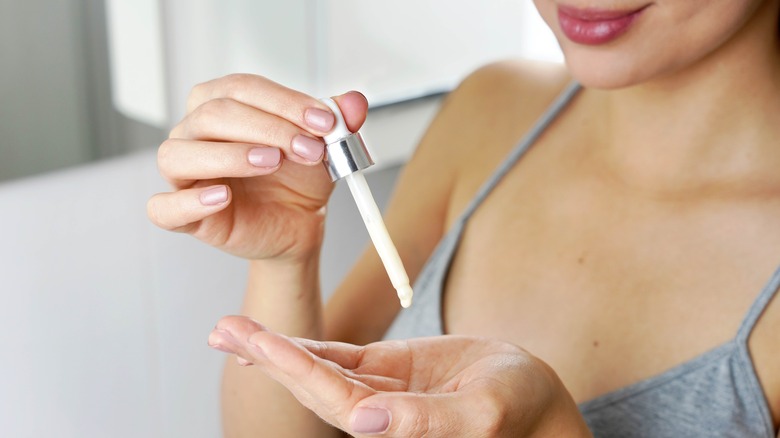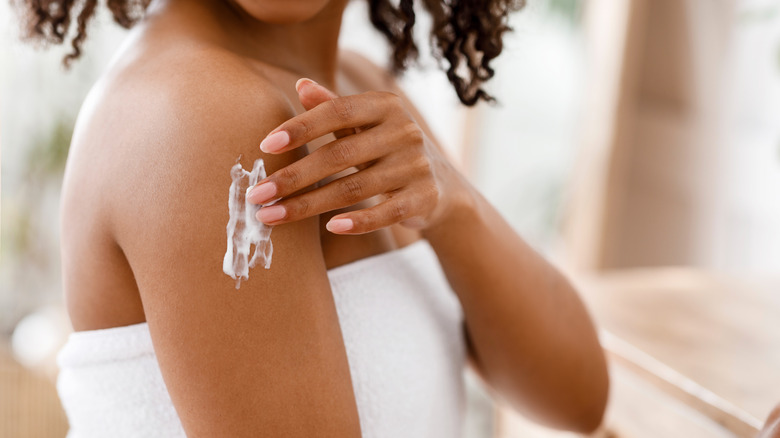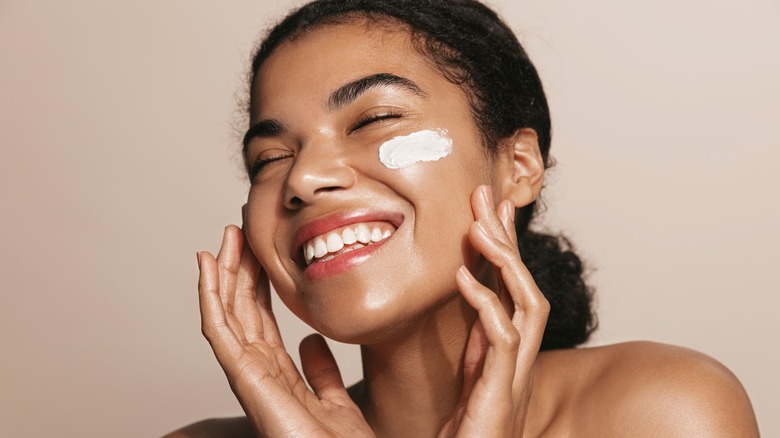What To Look For In Treatments For Keratosis Pilaris
If you suffer from rough, bumpy skin, you might actually have something known as keratosis pilaris, or KP. The small bumps caused by keratosis pilaris can show up anywhere on your body, but are most commonly found on your upper arms, thighs, cheeks, and even your butt (per Mayo Clinic). And while the condition is harmless and does not require treatment, the bumps and dry skin that often accompany them can put a damper on your self-esteem. Additionally, some people with severe cases may experience itchiness and irritation from the bumps, especially if they struggle with dry skin or sensitive skin to begin with.
KP is caused by the buildup of keratin, a naturally occurring protein meant to protect your skin. When the protein starts to build up, it can clog hair follicles, leading to the condition's notorious red, annoying bumps. And while experts are divided over what exactly causes the buildup of keratin, most agree that genetics are likely the main cause — and the genetic traits that cause KP are a lot more common than you might think. "KP affects 40 to 80% of the general population at some time in their life, and it affects all races and ages," said dermatologist Stephen Matlock via Good Housekeeping.
While there are many over-the-counter treatments for KP on the market, experts say there are certain properties that you should be on the lookout for.
Keratolytic Ingredients
The use of keratolytics is one of the most effective ways to treat unsightly and annoying KP flare-ups. Often referred to as chemical exfoliants, formulas containing keratolytic ingredients work to break down the buildup of dead skin cells and keratin, which can help improve the look and feel of KP (per American Academy of Dermatology Association). "Alpha and Beta Hydroxy acids are the best treatment for KP," Laura Dyer, a certified physician's assistant, said via Marie Claire. "Look for products with salicylic, glycolic, or lactic acid to help exfoliate and smooth the skin."
According to dermatologist Nava Greenfield, formulas containing keratolytic ingredients such as glycolic, salicylic, and lactic acid in addition to ammonium lactate are great at breaking down dead skin, promoting cell turnover and exfoliation, as well as promoting healthy skin function by repairing its pH balance (via Byrdie).
Though slightly more uncommon to come by, other keratolytic agents such as urea and topical sulfur can also be particularly effective at treating KP. Board-certified dermatologist Dr. Melissa Kanchanapoomi Levin notes that topical sulfur, especially when used in conjunction with salicylic acid, is a gentle and effective way to break down the bonds found in keratin plugs thanks to the ingredient's anti-inflammatory properties (per Marie Claire).
Retinols and retinoids
While AHAs and BHAs are widely considered to be the quickest and most effective way to treat KP, if you deal with the annoying, red bumps on any part of your face, you might benefit from adding a retinol or retinoid to your daily skincare routine. "Vitamin A derivatives such as retinols and retinoids speed up your skin cell turnover, which prevents buildup of skin cells and, in turn, keratin, in the first place," said Dr. Levin (via Marie Claire).
Because retinol tends to be quite powerful and potent, it's important to start off slowly — especially if your skin is new to retinol altogether. Dermatologist Dr. Shereene Idriss recommends beginning by introducing your skin to a topical retinoid with a very light concentration to prevent your skin from drying out or becoming irritated (per The Cut). Start by using it every other day, working your way up to every day as your skin tolerates it. If you are using a retinoid to treat KP on your body, Dr. Idriss recommends diluting your retinoid in a lactic acid moisturizer, since skin other areas on your body tends to be less sensitive than the skin on your face and can handle a little double duty.
Hydrating formulas
Because dry skin can make your KP worse, it's important to invest in products that will help moisturize your skin while helping treat your bumps. "Keratosis pilaris is commonly seen in people who have eczema or other conditions that make their skin prone to dryness," said dermatologist Geeta Yadav via Good Housekeeping. She also noted that KP tends to get worse during the dry, cold winter months. "Every patient with KP should be using a good cream at least once daily to help retain moisture and soften the bumps," added dermatologist Stephen Matlock. You should apply moisturizing cream to damp skin after showering or bathing in the same direction as your hair grows so you don't irritate the hair follicles even further, according to consultant dermatologist Dr. Justine Kluk (per Elle).
In addition to investing in a quality cream moisturizer that will help add additional hydration to your skin, it's a good idea to choose a KP treatment with a formula that will work to hydrate your skin while also treating it. Board-certified dermatologist Dr. Melissa Kanchanapoomi Levin recommends opting for a KP treatment formula that contains ingredients like bisabolol, glycerin, and dimethicone which can help calm your skin and provide relief from any irritation and inflammation while also working to moisturize it (per Marie Claire). Some treatments also contain hyaluronic acid, which helps your skin retain moisture.
Non-comedogenic, oil-free, and fragrance-free formulas
Experts recommend a regular routine of cleansing, exfoliating, and moisturizing to tackle stubborn KP, and if you struggle with bumps, redness, and dryness, make sure any cleansers, exfoliators, and moisturizers you use are oil-free, fragrance-free, and non-comedogenic. According to dermatologist Craig Austin, keratosis pilaris can actually be made worse by body products such as lotions, body washes, and soaps that contain harsh fragrances (via Women's Health). These products can irritate your already sensitive skin, and worsen the feel and appearance of your bumps and redness.
Because your KP is caused by clogged hair follicles, body and skincare products containing heavy oils and other comedogenic properties can further clog your pores and exacerbate your condition. Clogged pores can lead to not only worsened bumps caused by keratosis pilaris, but they can also cause you to break out and lead to acne on top of your already-troubled skin, creating a one-two punch of annoying and unsightly skin issues. Opting for body care products that are labeled as being oil-free, fragrance-free, and non-comedogenic can help keep other skin issues at bay so you can focus on treating your KP.
